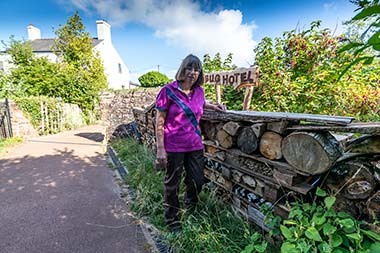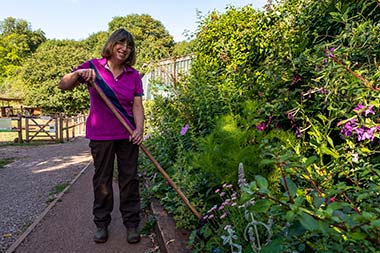
Whilst Puzzlewood is famous for its ancient woodland, we’re also very proud of our gardens – and of all the hard work that Jane, our gardener, puts in to keep everything looking beautiful year round.
 To find out more about what she does, we asked Jane to put down her secateurs for a few minutes and answer a few questions.
To find out more about what she does, we asked Jane to put down her secateurs for a few minutes and answer a few questions.
How long have you worked at Puzzlewood?
I’ve been here for around six years. Helen (who runs Puzzlewood) discovered that I was a gardener before I had my children, invited me to have a look around the gardens and I was immediately hooked by the thought of working in them! I could see that there were many well established roses and shrubs, but there was so much potential to create something special and I couldn’t wait to get started.
What does a typical day look like?
I start in the greenhouse, so watering is my first job. Then it’s a walk around the gardens dead-heading, weeding and checking for greenfly and other pests, essentially keeping everything looking as good as possible for the enjoyment of our visitors. Maintaining the willow maze is also my responsibility, as is directing the other members of the gardening team.
How have you changed or developed the gardens?
 I’ve created new flower beds in the gardens and around the holiday cottages. I always try to ensure there is interest all year round by planting shrubs that will flower in the winter, planting spring bulbs for vibrant colour early in the year, perennials for the summer months, along with annuals. And I always make sure we have asters for the autumn months – they add a last splash of colour before winter hits.
I’ve created new flower beds in the gardens and around the holiday cottages. I always try to ensure there is interest all year round by planting shrubs that will flower in the winter, planting spring bulbs for vibrant colour early in the year, perennials for the summer months, along with annuals. And I always make sure we have asters for the autumn months – they add a last splash of colour before winter hits.
We also have a small vegetable patch, which is where we grow the pumpkins that decorate the wood at Halloween. This area also doubles as a nursery bed to grow cuttings and grow flowers from seed, which also makes us quite self-sufficient.
This year we created a new bed next to the willow maze. We planted a mixture of cornflowers, cosmos, pot marigolds and poppies. It creates a wonderful splash of colour but, most importantly, it provides much needed nectar for the visiting bees and pollenating insects.
Do you ever face any challenges at Puzzlewood?
The soil is predominately a heavy clay, which means it can only be easily dug and seed beds made in mid-autumn and mid to late spring. I try to improve the quality of the soil by incorporating well-rotted manure and compost and have tried to work the ground when it’s not wet. Not all plants will thrive in these conditions, but Heucheras, Japanese Anemones, Euonymus all do very well. Buddleia also likes clay soil, which is good news for the butterfly and bee population.
Talking of which, have you introduced any initiatives to help the environment?
 As well as introducing buddleia, we’ve planted sedums to attract butterflies. Asters, wall flowers, hardy geraniums, foxgloves and primroses are all good sources of nectar and pollen for bees and other insects. Although I want the garden to look good, I don’t try to be too ‘tidy’. The walls have an abundance of ivy where birds and insects can make their homes, and flowers such as sunflowers, which provide a good source of food for the birds, are left alone once they’ve gone over. I also avoid the use of fungicides and insecticides as much as possible.
As well as introducing buddleia, we’ve planted sedums to attract butterflies. Asters, wall flowers, hardy geraniums, foxgloves and primroses are all good sources of nectar and pollen for bees and other insects. Although I want the garden to look good, I don’t try to be too ‘tidy’. The walls have an abundance of ivy where birds and insects can make their homes, and flowers such as sunflowers, which provide a good source of food for the birds, are left alone once they’ve gone over. I also avoid the use of fungicides and insecticides as much as possible.
I’m quite proud of our Bug Hotel. There is an area of land near the road that was proving difficult to cultivate and was prone to flooding, so it was the perfect site for a wildlife stack. It’s made with a variety of natural materials to attract and shelter all kinds of insect life. It looks great and our visitors – especially children – love peering into it!
What do you like most about working at Puzzlewood?
Not only am I doing a job I love, I get to meet lots of interesting people. Most of our visitors are on holiday or out for the day, which generally means they are on good form and many like to find out what we’re doing in the gardens – I’m always very happy to answer their questions. Returning visitors will often comment on how the gardens have improved over the years, which is always nice to hear. We also get lots of visits from schools. The children, who are often from inner-city areas, get so excited about the animals and the gardens. Their enthusiasm is infectious and it’s fun to chat with them.
Do you think there are enough women working in horticulture?
 I think it’s hard to attract young people into the industry, whatever their gender – maybe they just don’t consider it as a career option or see it is a hobby for older people. People often don’t discover their passion for gardening until they have their own garden, but it’s never too late to change direction. Even I sort of fell into gardening. I trained and worked in agriculture for five years before switching to work in a horticultural wholesale nursery. I stayed for 10 years and worked my way up through the ranks, gaining invaluable knowledge for when I set up as a gardener.
I think it’s hard to attract young people into the industry, whatever their gender – maybe they just don’t consider it as a career option or see it is a hobby for older people. People often don’t discover their passion for gardening until they have their own garden, but it’s never too late to change direction. Even I sort of fell into gardening. I trained and worked in agriculture for five years before switching to work in a horticultural wholesale nursery. I stayed for 10 years and worked my way up through the ranks, gaining invaluable knowledge for when I set up as a gardener.
And when you’re not gardening, what do you do?
Well I’ve got two daughters so they keep me busy. I’m married to a farmer, so I work on the farm. And because my first love is sheep, I have a flock of Texel sheep to tend.
Don’t forget to say hello to Jane next time you visit Puzzlewood – whether you want to identify a plant you’ve spotted or need advice about planting in your own garden, she’ll be more than happy to chat!







